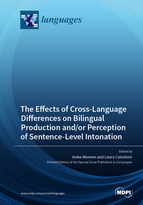The Effects of Cross-Language Differences on Bilingual Production and/or Perception of Sentence-Level Intonation
A special issue of Languages (ISSN 2226-471X).
Deadline for manuscript submissions: closed (28 February 2022) | Viewed by 21617
Special Issue Editors
Interests: intonation; second language acquisition; first language attrition; phonetics; intonational phonology
Special Issue Information
Dear Colleagues,
The goal of this Special Issue is to collect state-of-the art articles on the intonational patterns of different types of bilinguals (e.g., second language learners; heritage speakers; simultaneous bilinguals). The focus will be on the perception and/or production of sentence-level patterns, such as the marking of information structure, the realization of sentence types or the phonetic realization of intonational events (pitch accents or boundary tones). We particularly encourage papers on understudied language pairings.
Research on intonation and bilingualism has expanded in the last ten years to include a variety of structures and of languages in contact, but it still remains an underexplored territory (Trouvain & Braun 2020) with very few models that have attempted to account for what aspects can be transferred from language to language (Mennen 2015). There are many questions that remain unanswered: Can we determine a hierarchy of difficulty or transferability? How does prosody interact with other components of the grammar, such as morphology or syntax, in a contact situation? Which aspects are more prone to bidirectional interference? Which changes in intonation make speakers sound foreign in their second (or first) language?
There are very few thematic volumes on the topic (e.g., Delais-Roussarie et al. 2015), and even fewer Special Issues (e.g., the Special Issue of Studies in Second Language Acquisition edited by Mennen & De Leeuw, 2014) that gather state-of-the art experimental research. Thus, we believe that a volume with experimental contributions that cover a wide variety of languages would both deepen our understanding of intonation more broadly and broadcast new methodological developments in the analysis of intonation.
We request that, prior to submitting a manuscript, interested authors initially submit a proposed title and an abstract of 400-600 words summarizing their intended contribution. Please send it to the guest editors (Email A) or to /Languages/ editorial office (languages@mdpi.com). Abstracts will be reviewed by the guest editors for the purposes of ensuring proper fit within the scope of the Special Issue. Full manuscripts will undergo double-blind peer-review.
Tentative completion schedule:
- Abstract submission deadline: 29 October 2021
- Notification of abstract acceptance: 15 November 2021
- Full manuscript deadline: 28 February 2022
References
Delais-Roussarie, Elizabeth; Avanzi, Mathieu & Herment, Sophie (Eds.). (2015). Prosody and Languages in Contact: L2 acquisition, attrition, languages in multilingual situations. Springer Verlag.
Mennen, Ineke. (2015). Beyond segments: towards a L2 intonation learning theory. In: Delais-Roussarie, E.; Avanzi, M. & Herment, S. (Eds.). Prosody and Languages in Contact: L2 acquisition, attrition, languages in multilingual situations (pp. 171-188). Springer Verlag.
Mennen, I., & De Leeuw, E. (2014). BEYOND SEGMENTS: Prosody in SLA. Studies in Second Language Acquisition, 36(2), 183-194. doi:10.1017/S0272263114000138.
Trouvain, Jürgen & Braun, Bettina. (2020). Sentence Prosody in a Second Language. In: Gussenhoven, C., & Chen, A., The Oxford Handbook of Language Prosody (pp. 605-618).
Prof. Dr. Ineke Mennen
Prof. Dr. Laura Colantoni
Guest Editors
Manuscript Submission Information
Manuscripts should be submitted online at www.mdpi.com by registering and logging in to this website. Once you are registered, click here to go to the submission form. Manuscripts can be submitted until the deadline. All submissions that pass pre-check are peer-reviewed. Accepted papers will be published continuously in the journal (as soon as accepted) and will be listed together on the special issue website. Research articles, review articles as well as short communications are invited. For planned papers, a title and short abstract (about 100 words) can be sent to the Editorial Office for announcement on this website.
Submitted manuscripts should not have been published previously, nor be under consideration for publication elsewhere (except conference proceedings papers). All manuscripts are thoroughly refereed through a double-blind peer-review process. A guide for authors and other relevant information for submission of manuscripts is available on the Instructions for Authors page. Languages is an international peer-reviewed open access monthly journal published by MDPI.
Please visit the Instructions for Authors page before submitting a manuscript. The Article Processing Charge (APC) for publication in this open access journal is 1400 CHF (Swiss Francs). Submitted papers should be well formatted and use good English. Authors may use MDPI's English editing service prior to publication or during author revisions.
Keywords
- intonation
- bilingualism
- second language acquisition
- perception
- production
- first language attrition







